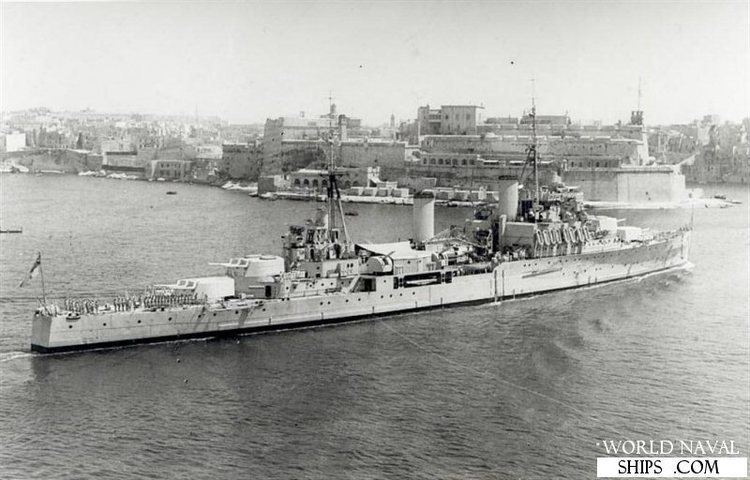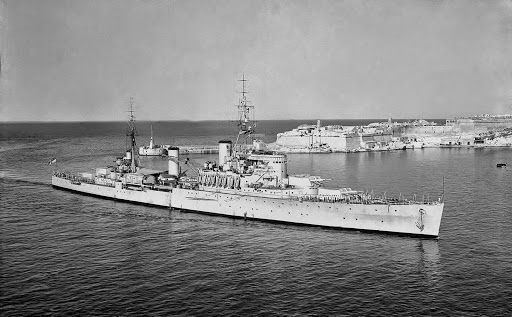Ordered 20 December 1937 Commissioned 23 September 1940 Launched 18 July 1939 Draft 5 m | Laid down 8 February 1938 Construction started 8 February 1938 Length 169 m Builder Vickers-Armstrongs | |
 | ||
Out of service Sold to Indian Navy as Mysore, 29 August 1957 | ||
HMS Nigeria (pennant number 60) was a Crown Colony-class light cruiser of the Royal Navy completed early in World War II and served throughout that conflict. She was named for the British colony of Nigeria.
Contents

Home waters

Nigeria served in Home waters and off the Scandinavian coast for the early part of the war. On 28 June 1941 Nigeria, in company with the destroyers Bedouin, Tartar and Jupiter intercepted the German weather ship Lauenburg in thick fog north-east of Jan Mayen Island. The German ship was detected through the use of HF/DF. The crew of Lauenburg abandoned ship after they were fired upon, allowing the British to board her. Valuable codebooks and parts of the Enigma machine were found aboard and recovered. This was one of the earliest captures of Enigma material of the war, and came a few weeks after the destroyer Bulldog had captured the first complete Enigma machine from the German submarine U-110 on 9 May 1941.

In July 1941, Nigeria became the flagship of Force K, commanded by Rear Admiral Philip Vian. During this period, Force K made two expeditions to Spitsbergen (Norwegian territory), the first to ascertain the situation and the second, in September, to escort a troopship, Empress of Australia, with Canadian troops and a team of demolition experts (see Operation Gauntlet). Their task was to evacuate Norwegian and Soviet personnel from the archipelago and destroy coalmines and fuel stocks that might be of use to the enemy. Bear Island was also visited to destroy a German weather station. The two cruisers of the task force, Nigeria and Aurora diverted to intercept a German convoy. During this action, Nigeria sank the German training ship Bremse, but suffered serious damage to her bow, possibly having detonated a mine. On return to Britain, she was sent to Newcastle for repairs.
The Mediterranean and Far East

Nigeria was then assigned to operate in the Mediterranean. On 12 August 1942 she was participating in Operation Pedestal, escorting a convoy bound for Malta. She was the flagship of the close escort group, commanded by Admiral Harold Burrough. Nigeria was torpedoed and damaged by the Italian submarine Axum but managed to make it back to Gibraltar escorted by three destroyers. Admiral Burrough meanwhile transferred his flag to the destroyer Ashanti whilst Nigeria returned to Gibraltar.
She was sent from there to the United States for repairs, which took nine months to complete. After these were complete, she operated off the South African coast, and on 12 March 1943 she picked up 30 survivors from the American merchant James B. Stephens that was torpedoed and sunk on 8 March 1943 by the German submarine U-160 about 150 nautical miles (280 km) north-east of Durban. Nigeria was then assigned to operate with the Eastern Fleet from February 1944 until December 1945, when she returned to the UK to be refitted. During her time in the far east, she participated in raids on Sumatra.
Post war
Nigeria survived the war and continued in service with the Royal Navy, as the only Colony-class cruiser, maintaining 4 triple 6 inch turrets, X turret finally being removed in 1954. In 1954 it was sold to India and went under reconstruction, largely on the pattern of the HMS Newfoundland rebuild, possibly incorporating some of the electronics and radar intended by the RAN to be used on the refit of HMAS Hobart, which was abandoned. On 29 August 1957 when she recomissioned into the Indian Navy, who renamed her Mysore. During her time with the Indian Navy, she collided with the destroyer HMS Hogue, severely damaging Hogue's bow. Mysore was in service with them for a further 28 years until she was decommissioned on 20 August 1985.
